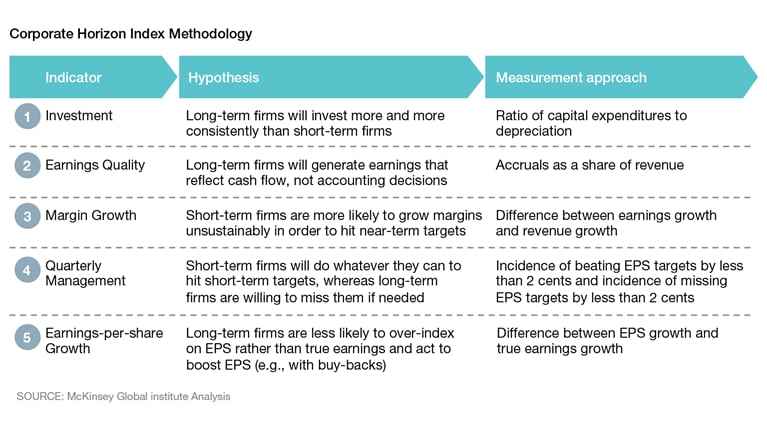For the past 3 decades, leaders in business, government, and academia have debated whether the unrelenting focus on quarterly profits at the expense of long-term commitments has undermined the growth potential of companies and even the economy.
We believe it has. For years, McKinsey has encouraged businesses to take the long view. It underlies our concept of organizational health developed almost 20 years ago: if a company manages only for its short-term performance—without minding its health—it won’t last.
My ingoing assumption was that there were too many factors driving corporate performance—I was surprised, in a good way, that we could come up with meaningful results with only five [factors].
Tim Koller, partner
To create long-term value, we urged companies to look beyond immediate product cycles and redefine their relationships with their customers, employees, and communities—to solve mutually relevant problems and protect resources.
In a landmark 2011 Harvard Business Review article, Managing Director Dominic Barton outlined a road map for shifting companies to a longer-term orientation.
We helped create Focusing Capital on the Long Term, a global not-for-profit coalition which creates practical tools for companies, including a CEO survey last fall highlighting the pressures for short-term decision making.
So while there was a lot of anecdotal evidence, it was clear that the best way to advance the conversation was through data. “We wanted to quantify what we instinctively believed to be true,” said Jonathan Godsall, an associate partner. A small team from the McKinsey Global Institute (MGI) was organized, and in 6 months they developed the Corporate Horizon Index, a survey of 615 companies’ performance across five key indicators over 15 years. The index provides the first statistical evidence that shows the positive influence that long-term thinking can have on a company’s performance.

“The hardest part of our research was looking for the less obvious factors that indicated a short- or long-term orientation. For example, there’s a myth that companies should have smooth earnings growth and meet quarterly earnings consensus. Long-term companies are not concerned with managing short-term earnings and are less likely to consistently hit earnings consensus or to have smooth earnings growth,” explains Tim Koller, McKinsey partner and coauthor of the bestselling book Valuation, now in its sixth edition.

For Jack McGinn, a recent-graduate hire with a degree in applied math, this was exactly his sort of problem solving. “We worked from hypotheses on how short-term decision making would manifest in a company’s financial disclosures. Then we created indicators based on these hypotheses and refined them so they could be applied to companies of different sizes and performance levels.”
After conferring with external academics, they ultimately settled on five factors. Our Corporate Performance Analytics team began pulling the data across these factors—and in January, the index was ready.
After running the numbers, it was clear that the group of 164 long-term focused companies performed significantly better than those 451 with a short-term lens. Their average revenue and earnings growth were 47 and 36 percent higher respectively, and they added nearly 12,000 more jobs than their short-term peers. Interesting to note, a small number of the companies even shifted from a shorter-term to a longer-term view over the 15-year period.
A recent Harvard Business Review piece summarizes the findings of the MGI paper.
So what gives some companies the vision and courage to make and stick with their decisions—despite tremendous external pressures? And how can we help others follow suit? We are conducting extensive interviews to understand how companies make decisions and identify the traits of those who take a long view, such as tenure of the ceo; employee incentives; values and culture; and the makeup of the board.
“For example, one of the factors we are finding in outperforming companies is that they often set targets using a grassroots, bottoms-up approach—rather than top down,” says Tim. “They benefit from having more balanced view.” One challenge will be how to get companies to start thinking longer term when they are doing relatively well now and don’t even think there’s a problem.